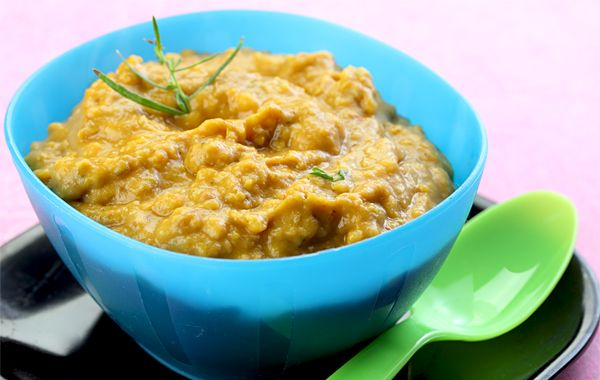I had a lot of leftover soaked chickpeas after making chole (spicy Indian garbanzo beans), so I prepared a simple chickpea soup. I added potatoes that are invading part of our garden now, onions, a touch of lemon and whatever vegetables I was able to find in the kitchen (frozen corn, carrots and roasted red bell peppers). The result was surprisingly fabulous, especially since it’s gluten free, dairy free and low fat. You could sprinkle a few Parmesan shavings for added richness if you like, but since there’s no photographic evidence, I’m going to say I didn’t!
I prepared the chickpea soup with the idea that it was going to be for my baby daughter, but all the grown-ups in our home enjoyed it just as much as she did. She’s old enough to eat meat, fish and other solid carbs but I still prepare soups for her several times a week to ensure she doesn’t go too hungry. According to my husband, she’s plenty chubby but I guess through a mommy’s eyes, there’s always the fear of not providing enough for your baby.
1. Info for Chickpea Soup Recipe
- Cook Time: unavailable
- Total Time: unavailable
- Servings: 6
- Calories: unavailable
2. Ingredients for Chickpea Soup Recipe
- 3 small roasted bell peppers
- 1 pound dried chickpeas
- 1 bay leaf
- 1 white onion, chopped
- 2 tablespoons olive oil
- 1 teaspoon ground cumin
- 2 teaspoons salt
- 1 teaspoon white pepper, freshly ground
- 1 cup mixed carrotr, corn and green beans, thawed
- 1 quart vegetable broth (or water plus bouillon), as needed
- 1 sprig tarragon
- juice of 1 lemon
3. Directions:
- Prepping the chickpeas: In a bowl wash the chickpeas thoroughly (about 3 cups of dried chickpeas). Pick out and discard any badly-shaped beans, then soak them for at least 1 hour, preferably overnight. Drain as much liquid as possible. Set aside.
- Pre-cooking the chickpeas; how to use a pressure cooker:
- Heat 2 tablespoons of oil in a pressure cooker (without the lid). Once the oil is hot, add the onions and cook until lightly golden. Add the soaked chickpeas, bay leaf, 1 teaspoon salt, cumin and cover with 2 quarts water. Carefully seal the pressure cooker with the lid and lock it. Put it on high heat, then start counting the cooking time after it’s started to steam. At this point you can turn down the heat, but it has to continue steaming; you have to barely hear the whistling or it’s not cooking properly. In any case, follow the instructions for your own pressure cooker (depending on which model you may have). Cook for 35-40 minutes total. Remove from the heat. Run cold water to lower the temperature and let stand for about 10 minutes, removing as much steam as possible. Remove the lid (I had to call my husband Lulu for help). Drain the liquid. Let cool for about 15-20 minutes. Remove and discard the bay leaf pieces. Gather about ¾ of the cooked chickpeas (I reserved the rest for another dish). Drizzle with lemon juice.
- Assembly time:
- In a food processor, combine the coarsely chopped roasted bell peppers, the cooked chickpeas, boiled potatoes, paprika, tarragon and mixed vegetables. Add vegetable broth for a smoother flow. Mix until the machine flows smoothly (you don’t have to over-blend it; coarse pieces should still be visible). Adjust seasoning with salt and white pepper. When you’re ready to serve, reheat the soup for 10 minutes. Add more vegetable broth to your liking.
- Ladle the soup into individual serving bowls. Garnish with fresh sprigs of tarragon.
- You could serve with garlic bread or cheese twists on the side.
- Bon appétit!
4. Tips and advices:
- You can find chickpeas (chana dal, also known as split Bengal gram or dried garbanzo beans) at any Indian store at a very low cost.
- Little reminder on how to roast bell peppers in the oven: Preheat your oven to 450°F. Cut the bell peppers in half lengthwise. Seed them and spread the peppers evenly on a cookie sheet brushed with oil, in a single layer. Roast the peppers for about 4-5 minutes until the skins blister and darken. Watch carefully so they don’t burn. Wrap each pepper in aluminum foil or in a large zip-top plastic bag. Let cool for about 5-10 minutes until you can handle them without discomfort. Clean and remove the skin from the peppers using a knife (or under running water); the skin will come right off. Coarsely chop the flesh. If you want to store roasted bell peppers, drizzle with oil and season with salt; set aside in the refrigerator until needed.

